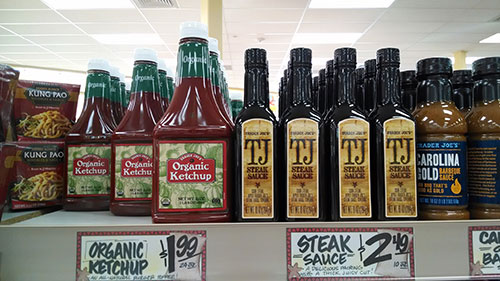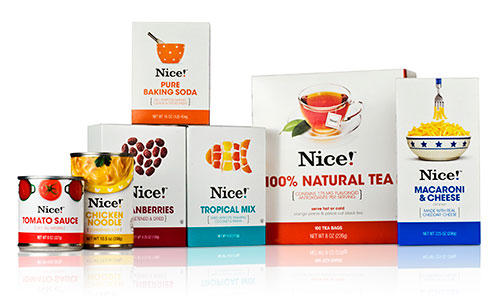Generic Internet Article
Private labels are a common strategy retailers use to keep profits in house, but fortunately for everyone, house brands are a lot less boring these days.
33%

(tales of a wandering youkai/Flickr)
Private labels: From high-market to low-market and back again
Walking into a Trader Joe's store in 2015 is a fascinating experience. You're not just buying cookie butter; you're buying into the idea that a single company is creative enough to be able to sell cookie butter under the same brand as its beer and cereal.
It makes them look like geniuses, because they were able to make the experience about them rather than all the products they sell. It seems brilliant, but in a lot of ways, they're not doing things much differently from Ralphs, besides maybe spending a lot more on graphic design.
Most retailers meet this approach somewhere in the middle. If you go into a Target, you'll see Mossimo and Converse One Star on the shelves. If you've ever bought a cheap TV from Best Buy, it's probably branded Insignia or Dynex. And legacy department stores like JC Penney and Sears have house brands so closely associated with certain lines of products that you'd never realize that they were house brands.
There's a good reason why retailers and grocery stores have so many private labels. It comes down to one thing: profit. If you can keep people coming back looking for a specific brand name that you create, you don't have to split the profit with someone else, creating a wholly vertical experience.
A good example of this in action is one of the earliest private-label companies, the luxury men's clothing manufacturer Brooks Brothers. The firm could create their own shirts, their own shoes, their own ties, and just about everything else, and because it was exclusive to their stores, they had both exclusivity and complete vertical control over the market. The result is that people who want Brooks Brothers products have to go to their store—and it's been that way since the company started in the early 19th century.
But, let's be honest; we don't think of snazzy menswear when we think of house products; we think of Ralphs. You can thank A&P for that.
The lawsuit that brought us generic food
See, back in the early 20th century, A&P got very upset when one of its vendors, Cream of Wheat, put its foot down and set a price for one of its products. So A&P sued the company, claiming monopolistic behavior. The court ruled in Cream of Wheat's favor, and argued that A&P itself was the firm acting unfairly and abusing its market power.
In light of this rebuke, A&P decided to … well, act unfairly and abuse its market power some more. As other food-makers were taking stock of the ruling and making their own demands, A&P created private-label products that could undercut the competition through wholesaling.
And that's how we got store brands.
Four random facts about private-label goods
- One of Abraham Lincoln's closest friends, Jacob Bunn, was a major manufacturer of generic goods. Bunn and Lincoln met in the 1830s, when the future president worked at Bunn's lawyer after he opened a general store. (Before becoming a lawyer, Lincoln ran a grocery store of his own.) Bunn's company, J.W. Bunn & Co., capitalized on Lincoln's success by naming a brand of coffee after him.
- Some notable products started as private-label goods before breaking out of their general-store roots. The most notable of these was a beverage sold out of Bradham's Drug Store's in New Bern, North Carolina. Caleb Davis Bradham's beverage, which he called "Brad's Drink," eventually gained a strong reputation, leading Bradham to change the name to something more familiar: Pepsi.
- Milk is probably the one product most people buy that almost always features a generic label. The reason for this, according to a Nielsen study, is that there are often few differentiators between different kinds of milk products, and because people buy it so often and it doesn't change very much, price generally is less of a factor.
- If you're looking to create something that features your own label on it, the best option to do so is probably China. According to the website China Importal, adding your own branding to a product generally adds around 20 to 40 cents to the wholesale cost.
"Some brand-name manufacturers make private-label goods only to use occasional excess production capacity. In those circumstances, private-label production may seem tempting. But beware. Although the system may work well for a company for a time, private-label production can become a narcotic."
— A 1996 Harvard Business Review article, recommending that manufacturers avoid creating private-label products for other companies if they haven't yet started. Authors John Quelch and David Harding go on to say that when private-label branding competes with a company's own offering, it leads to confused branding and cannibalization.

Generic Brands Are Trying Harder These Days
You might be wondering to yourself: Why don't generic brands look like the products in Repo Man anymore? And the short answer is this: We care more about design these days, and as a result, manufacturers are tying harder.
The consulting firm Full Surge notes that much of this seems to be a concerted effort by retail firms to better align products with a broader brand—and, as a result, emphasize that the product being sold is high-quality in nature and, furthermore, creates an emotional connection with the end user.
"Consumers tend to gravitate toward (and remain loyal to) brands because they feel an emotional connection to them," writes Full Surge Managing Partner Mitch Duckler. "This is no different for private label brands than for national manufacturer brands. It is important for private label brands to stand for something more than merely price/value—and even more than a product attribute—they need to provide an emotional benefit that consumers can relate to."
There's a reason why you feel taken aback by the clear white products in the Repo Man grocery-store scene. The products have simple design that is technically "good" design, but it feels too clinical. You don't feel anything when you look at a can of peaches that doesn't identify itself using anything but a line of text.
Grocery stores, by and large, have figured this out, and the result is that when you look to buy something these days, you're more likely to see a consistent, but pretty design that actually gives a flavor of the product you're about to use.
This is where the world should be going. Down with mystery meat branding.
“Our findings indicate that in making their brand choices, many consumers are willing to sacrifice distinctiveness and individuality in order to reduce the possibility of disapproval by others.”
— University of Missouri researcher Eunjin Kim, discussing the findings of a recent study by the school that shows many people would rather have generic clothing with no additional branding than clothing with branding that draws attention to itself. It's all about the idea of insecurity; if you may face ostracism in your social circle for wearing an American Eagle shirt, why would you want to wear one?
You'd think the ultra-generic approach to branding was going out of fashion, but there's always room to be proven wrong. The company that's proving us wrong this time? Walmart. Back in 2013, the company launched a new private-label brand for low-end essentials like spaghetti, laundry detergent, and peanut butter.
It seems like it'd be challenging, but Walmart's labeling is somehow more boring than the old Ralphs labeling, using solid blue coloring, and white, all-caps Helvetica type. It makes you cry for your soul in a way.
"While I applaud Walmart finally acknowledging the numerous unbranded and control label SKUs in grocery as private label products and creating a brand to tie them together—the 1970’s flashback design is at best disappointing, but at its worst it could set the industry back twenty years," wrote Christopher Durham, an expert on private labeling issues.
We feel your pain man. Dear John Lydon: We realize PiL just released a new album, but your next album should be a sequel to Album that uses the Walmart branding.
:format(jpeg)/2018/04/quplav7cdcghdvbcrlnt--1-.gif)
/2018/04/quplav7cdcghdvbcrlnt--1-.gif)

/uploads/ernie_crop.jpg)